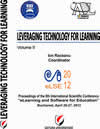RECENT SOFT COMPUTING APPROACHES IN DIGITAL LEARNING OBJECT EVALUATION
RECENT SOFT COMPUTING APPROACHES IN DIGITAL LEARNING OBJECT EVALUATION
Author(s): Florin Popentiu -Vladicescu, Grigore AlbeanuSubject(s): Education
Published by: Carol I National Defence University Publishing House
Keywords: Digital learning objects; multi-criteria decision-making; intuitionistic fuzzy approaches
Summary/Abstract: Digital learning objects are powerful units for building learning, education or training materials based on ICT recent developments. Not only text and photos, but also audio, video, and simulation units are used to build high quality e-lessons (available online), or blended learning resources. There are a large plethora of types of digital resources used in e-Learning content development, and for every category a particular set of criteria are used by experts (mainly e-education experts) to recommend some optimum configuration. Content quality (including presentation design), standards compliance (mainly for portability reason), learning goal alignment (accreditation goals), accessibility and interaction usability, and reusability are common criteria for every type of digital learning object. Specific aspects concerning text (font size/colour), images (resolution, multilevel approaches, animation), audio (resolution), video (resolution), and the general presentation including the quality of characters' voice are necessary to be taken into consideration in order to select the best quality digital learning objects in order to obtain an attractive, motivational, and efficient (not only for the teacher, but most important for the student) meeting with valuable pieces of knowledge for life. This paper describes the usage of some soft computing techniques for the evaluation of DLOs, including intuitionistic fuzzy multi-criteria approaches. Firstly, the multi-criteria decision-making methods are briefly reviewed combining the general decision-making process. There are many approaches in soft computing decision-making: neural networks, evolutionary optimisation, fuzzy computing, etc. The multi-criteria approaches under consideration are based on fuzzy and intuitionistic fuzzy numbers (triangular, trapezoidal, etc), distance evaluation, and multi-criteria decision strategies. Final considerations on applying such methodologies for digital learning objects' evaluation are presented.
Journal: Conference proceedings of »eLearning and Software for Education« (eLSE)
- Issue Year: 8/2012
- Issue No: 02
- Page Range: 16-21
- Page Count: 6
- Language: English

